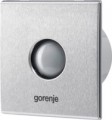Rotational speed
The nominal fan speed during operation.
The rotational speed is one of the factors affecting the performance and, consequently, the overall efficiency of the fan. At the same time, this factor is far from being the only one. A lot also depends on the design of the blades, their number, the diameter of the impeller, etc. Therefore, fans with the same speed can differ significantly in capabilities, and you should pay attention primarily to performance.
At the same time, the rotation speed still has a certain practical significance. On the one hand, faster fans produce more noise; this drawback can be compensated to a certain extent by design tricks, but they, in turn, noticeably affect the price. On the other hand, to ensure the desired level of performance, lower-speed fans must either have impellers of a larger diameter (which accordingly affects the dimensions, and in most cases, the installation size) or, again, use design tweaks that affect the price.
Mounting depth (duct)
Mounting depth of the fan with a standard installation method.
This parameter describes how deep into the duct the unit (or its parts in the case of surface-mounted models, see "Type") is placed during installation. Knowing the mounting depth, it is possible to assess the suitability of the selected model for a particular installation location: a flat section at the very beginning of the duct must be no less than the installation depth of the selected fan.
The smallest value of this parameter is typical for some overhead models of fans: in them, the main part of the structure is outside, and usually, only 2-3 centimetres are required for installation. And most of all, hidden units require space (see "Type").

